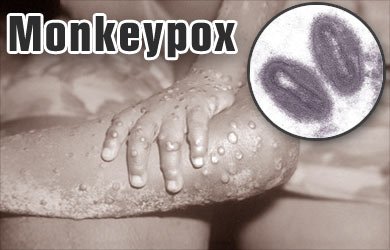HEALTH IS WEALTH : ALL YOU NEED TO KNOW ABOUT MONKEYPOX !{Causes, Symptoms, Signs, Diagnosis, Treatment, Prevention }
Monkeypox is a rare viral zoonosis (a virus transmitted to humans from animals) with symptoms in humans similar to those seen in the past in smallpox patients, although less severe. Smallpox was eradicated in 1980.However, monkeypox still occurs sporadically in some parts of Africa. Monkeypox is a member of the Orthopoxvirus genus in the family Poxviridae.
The virus was first identified in the State Serum Institute in Copenhagen, Denmark, in 1958 during an investigation into a pox-like disease among monkeys.
What are the Causes of Monkeypox?
Monkeypox is caused by the monkeypox virus, which belongs to the group of Orthopox viruses. There are two strains of the virus, the West African and the Central African strains. The West African strain appears to cause less severe illness as compared to the Central African strain. There are diverse natural mammalian carriers of monkeypox. However, it has only been isolated once from a squirrel (Funisciurus) in the Democratic Republic of Congo.
History
• -1958: First identified in Laboratory Monkey kept for research.
• -1970: First human case was identified in DR Congo.
• -1985: First Isolation in Nature, in an ailing rope squirrel in DR Congo.
• -2012: Second isolation in Nature, dead infant Mangabey in Cote d’Ivoire.
• -2003: First human infection outside Africa documented in USA.
• Continuous as an Endemic infection in West and Central Africa.
• -2017: Suspected outbreak in Bayelsa, Nigeria.
Key facts
• Monkeypox is a rare disease that occurs primarily in remote parts of Central and West Africa, near tropical rainforests.
• The monkeypox virus can cause a fatal illness in humans and, although it is similar to human smallpox which has been eradicated, it is much milder.
• The monkeypox virus is transmitted to people from various wild animals but has limited secondary spread through human-to-human transmission.
• Typically, case fatality in monkeypox outbreaks has been between 1% and 10%, with most deaths occurring in younger age groups.
• There is no treatment or vaccine available although prior smallpox vaccination was highly effective in preventing monkeypox as well.
Transmission
Infection of index cases results from direct contact with the blood, bodily fluids, or cutaneous or mucosal lesions of infected animals. In Africa human infections have been documented through the handling of infected monkeys, Gambian giant rats and squirrels, with rodents being the major reservoir of the virus. Eating inadequately cooked meat of infected animals is a possible risk factor.
Secondary, or human-to-human, transmission can result from close contact with infected respiratory tract secretions, skin lesions of an infected person or objects recently contaminated by patient fluids or lesion materials. Transmission occurs primarily via droplet respiratory particles usually requiring prolonged face-to-face contact, which puts household members of active cases at greater risk of infection.
Transmission can also occur by inoculation or via the placenta (congenital monkeypox). There is no evidence, to date, that person-to-person transmission alone can sustain monkeypox infections in the human population.
In recent animal studies of the prairie dog-human monkeypox model, two distinct clades of the virus were identified – the Congo Basin and the West African clades – with the former found to be more virulent.
Signs and symptoms
The incubation period (interval from infection to onset of symptoms) of monkeypox is usually from 6 to 16 days but can range from 5 to 21 days.
The infection can be divided into two periods:
I. The invasion period (0-5 days) characterized by
II. Fever
III. Headache
IV. Muscle aches
V. Backache
VI. Swollen lymph nodes
VII. Chills
VIII. Exhaustion(lack of energy)
The skin eruption period (within 1-3 days after appearance of fever) where the various stages of the rash appears, often beginning on the face and then spreading elsewhere on the body.
Lesions progress through the following stages before falling off:
• The face (in 95% of cases)
• Palms of the hands and soles of the feet (75%)
• Macules
• Papules
• Vesicles
• Pustules
• Scabs
Some patients develop severe lymphadenopathy (swollen lymph nodes) before the appearance of the rash, which is a distinctive feature of monkeypox compared to other similar diseases.
Monkeypox is usually a self-limited disease with the symptoms lasting from 14 to 21 days. Severe cases occur more commonly among children and are related to the extent of virus exposure, patient health status and severity of complications.
Diagnosis
The differential diagnoses that must be considered include other rash illnesses, such as, smallpox, chickenpox, measles, bacterial skin infections, scabies, syphilis, and medication-associated allergies. Lymphadenopathy during the prodromal stage of illness can be a clinical feature to distinguish it from smallpox.
Monkeypox can only be diagnosed definitively in the laboratory where the virus can be identified by a number of different tests:
• enzyme-linked immunosorbent assay (ELISA)
• antigen detection tests
• polymerase chain reaction (PCR) assay
• virus isolation by cell culture
Treatment and vaccine
There are no specific treatments or vaccines available for monkeypox infection, but outbreaks can be controlled. Vaccination against smallpox has been proven to be 85% effective in preventing monkeypox in the past but the vaccine is no longer available to the general public after it was discontinued following global smallpox eradication. Nevertheless, prior smallpox vaccination will likely result in a milder disease course.
Prevention
There are number of measures that can be taken to prevent infection with monkeypox virus:
• Avoid contact with animals that could harbor the virus (including animals that are sick or that have been found dead in areas where monkeypox occurs).
• Avoid contact with any materials, such as bedding, that has been in contact with a sick animal.
• Isolate infected patients from others who could be at risk for infection.
• Practice good hand hygiene after contact with infected animals or humans. For example, washing your hands with soap and water or using an alcohol-based hand sanitizer.
• Use personal protective equipment (PPE) when caring for patients.
In 2003, there was an outbreak of monkeypox virus in United States of America due to a shipment of an infected rodent from Africa. Hence, it is necessary to prevent the shipment of small rodents and other mammals from affected regions that may be carriers of the disease. Infected animals need to be quarantined. Any animal that comes in contact with the infected animal should also be quarantined for 30 days.
In healthcare environments, individuals should use proper protective gear before handling infected samples from the patient. It is suggested that a smallpox vaccination may shield the individual from monkeypox infection or he/she may have a very mild infection.
Monkeypox has been shown to cause death in as many as 1 in 10 persons who contract the disease.
Lets be careful please..
@chuxlouis
© Coindeskbitcoin
WhatsApp: +2348037188995
[email protected]

credit
Success Is Deliberate dear steemains
#MillionairesMindset
KINDLY
UPVOTE
RESTEEM
AND
COMMENT
Follow @chuxlouis




This post received a 3.13% upvote from @randowhale thanks to @chuxlouis! To learn more, check out @randowhale 101 - Everything You Need to Know!
@cmtzco has voted on behalf of @minnowpond. If you would like to recieve upvotes from minnowpond on all your posts, simply FOLLOW @minnowpond
Please upvote @abulhasanat I upvoted u
Done boss, I powered more than one of your posts ....More blessings
Where are you getting your information from?
Resteemed to over 5000 followers and 100% upvoted. Thank you for using my service!
Read here how the new bot from Berlin works.
@resteem.bot
@royrodgers has voted on behalf of @minnowpond. If you would like to recieve upvotes from minnowpond on all your posts, simply FOLLOW @minnowpond. To be Resteemed to 4k+ followers and upvoted heavier send 0.25SBD to @minnowpond with your posts url as the memo